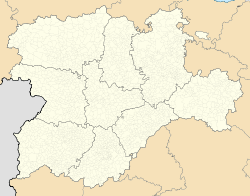
The Province of Burgos is a province of northern Spain, in the northeastern part of the autonomous community of Castile and León. It is bordered by the provinces of Palencia, Cantabria, Vizcaya, Álava, La Rioja, Soria, Segovia, and Valladolid. Burgos is the province of Spain that has borders with most provinces. Its capital is the city of Burgos.
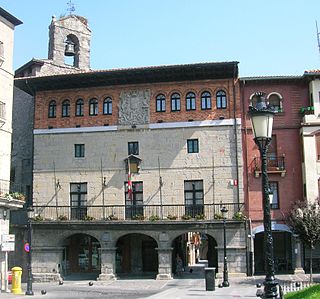
Urduña/Orduña is an exclave and municipality of 4,232 inhabitants located in the province of Biscay, in the autonomous community of Basque Country, in the North of Spain.

Sierra de las Nieves is a mountain range of the Penibaetic System in Málaga Province, Andalusia, Spain with its highest point being La Torrecilla

The Archdiocese of Burgos is Latin Metropolitan sees of the Catholic Church in Spain.

Cascajares de la Sierra is a municipality located in the province of Burgos, Castile and León, Spain. Its history goes back a long time ago. Remains have been found near the place that have occurred in many different time periods. There is a cathedral of paleoanthropology, and was recently named a World Heritage Site.
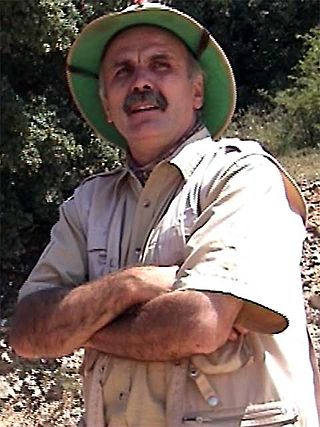
Eudald Carbonell i Roura is a Spanish archaeologist, anthropologist and paleontologist.

La Bureba is a comarca located in the northeast of the Province of Burgos in the autonomous community of Castile and León, Spain. It is bounded on the north by Las Merindades, east by the Comarca del Ebro, south-east by the Montes de Oca and south-west by the Alfoz de Burgos.
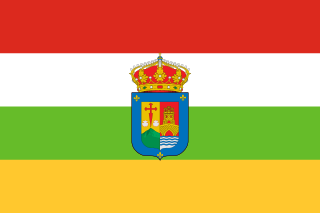
La Rioja is an autonomous community and province in Spain, in the north of the Iberian Peninsula. Its capital is Logroño. Other cities and towns in the province include Calahorra, Arnedo, Alfaro, Haro, Santo Domingo de la Calzada, and Nájera. It has an estimated population of 315,675 inhabitants, making it the least populated autonomous community of Spain.
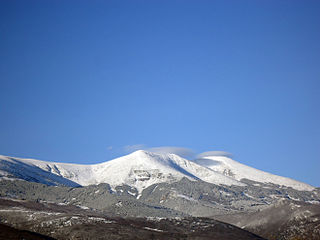
The Iberian System is one of the major systems of mountain ranges in Spain. It consists of a vast and complex area of mostly relatively high and rugged mountain chains and massifs located in the central region of the Iberian Peninsula, but reaching almost the Mediterranean coast in the Valencian Community in the east.

The Arlanza River rises in the Sierra de la Demanda, near Quintanar de la Sierra in an area known as Fuente Sanza. As it flows through the province of Burgos, Spain, it passes through the municipalities of Castrovido, Salas de los Infantes, Covarrubias and Lerma, broadly east to west roughly parallel to and north of the River Duero.

Sierra de la Demanda is a mountain sub-range situated in the northern Iberian Peninsula.

Sierra de la Demanda is a comarca located south-east of the province of Burgos in the autonomous community of Castile and León, Spain. It is bounded on the north-east by the Montes de Oca comarca, north-west by the Alfoz de Burgos, south-east by the province of Soria, south-west by the Ribera del Duero comarca, on the east by the province of La Rioja and west by the Arlanza comarca. It is named after the mountain sub-range of Sierra de la Demanda, the northwesternmost end of the Sistema Ibérico.
Nuestra Señora de la Vega is a town in the province of Burgos, Autonomous community of Castilla y León (Spain), region of Sierra de la Demanda, judicial district of Salas de los Infantes, Valdelaguna Valley City Council.
Hoyuelos de la Sierra is a settlement in Burgos, Castilla y León (Spain), within the municipality of Salas de los Infantes.

Piedrahita de Muñó is a Spanish town in the province of Burgos, Old Castile; an autonomous community of Castilla y León in the region of Sierra de la Demanda, judicial district of Salas.

Picos de Urbión, or "Urbion Peaks" is a mountain range in the Sistema Ibérico, Spain, limited by the Sierra de Neila and Sierra Cebollera of the same range. The ridge's highest summit, Pico Urbión, is 2,228 m) is one of the highest points in the 500 km long Sistema Ibérico.
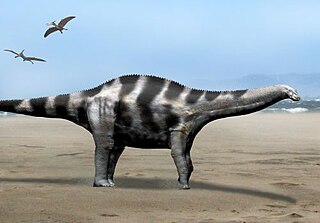
Demandasaurus is a genus of rebbachisaurid sauropod dinosaur from early Cretaceous deposits of Spain. Demandasaurus is known from an incomplete but associated skeleton that includes cranial and postcranial remains. It was collected from the Castrillo de la Reina Formation in Burgos Province of Spain. It was first named by Fidel Torcida Fernández-Baldor, José Ignacio Canudo, Pedro Huerta, Diego Montero, Xabier Pereda Suberbiola and Leonardo Salgado in 2011 and the type species is Demandasaurus darwini.

The Sierra de las Nieves National Park is a national park in the Sierra de las Nieves range, Andalusia, southern Spain. It is located behind Marbella and to the east of the road to Ronda from the Costa del Sol. In 2019, the Council of Ministers proposed to Parliament the transformation of the Natural Park into a National Park. On 1 July 2021, King Felipe VI gave royal assent to the Sierra de las Nieves National Park Act, which declares it as a National Park.

Ojo Guareña is a karst complex located in the Cantabrian Mountains of Castile and Leon, Spain, declared a natural monument by the government of Castile and Leon in 1996. It is composed of over 90 kilometres (56 mi) of galleries and passages within an area of some 13,850 hectares. The limestone formation containing the system is approximately 100 metres (330 ft) thick and sits on a massive water-resistant layer of marl. The caves were formed in the limestone by erosion sometime within the Coniacian Age. Ojo Guareña was considered the greatest karst system of the Iberian Peninsula until 2009, when a significant length of new passages was discovered in the Mortillano system. It is also the 24th longest cave system.
The Autovía BU-30 is a Spanish ring road that goes around the city of Burgos. Its principal role is that cars from Madrid, Valladolid, León, Santander, Logroño or Vitoria don't need to cross Burgos. It has a total length of 37.5 km, and some sections of the autovía are also part of European route E05 or European route E80



